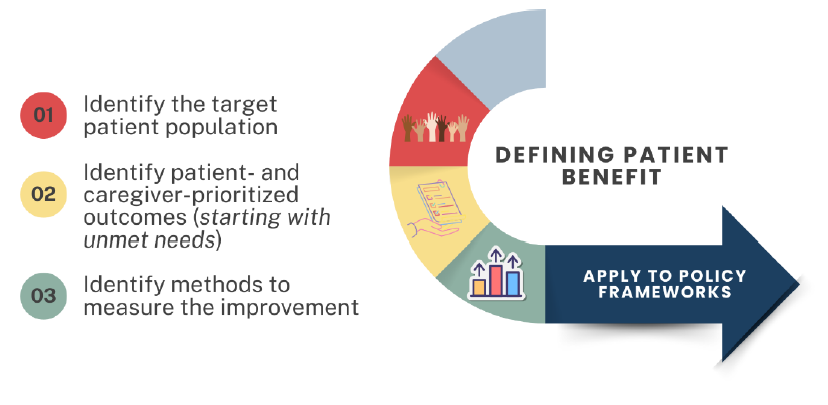Process for Defining Patient Benefit
 To reflect the patient communities’ evolving goals and needs, defining patient benefit needs to be an iterative process that refreshes on a regular basis to ensure it accounts for immediate and long-term impacts on patients’ lives while demonstrating responsiveness to evolving patient goals and needs. The process would include:
To reflect the patient communities’ evolving goals and needs, defining patient benefit needs to be an iterative process that refreshes on a regular basis to ensure it accounts for immediate and long-term impacts on patients’ lives while demonstrating responsiveness to evolving patient goals and needs. The process would include:
- Identifying the target patient population for the item, therapy or service to be evaluated for use in the health care setting.
- Identifying patient and caregiver prioritized outcomes:
- Through engaging and collaborating with patients and their communities identified in step 1, identify all the health-related outcomes that matter to them and their care partners, starting with unmet needs.
- Using scientifically validated approaches, assess the relative priorities and weights of each outcome through quantitative patient preference methods.
- Through engaging and collaboration with patients and their communities, establish a focused set of health-related outcomes that can be measured.
- Identifying methods to measure the improvement in the prioritized outcomes.
Out of scope of this process and definition includes financial metrics impacts, including costs to the health care system or the individual patients and their care partners. While these factors can be considerable factors in the outcome of a potential treatment or service, they can more adequately be quantified through health economics methods.
Why is this Important?
- Align healthcare delivery with patient needs and goals.
- Create a more patient-centered healthcare system.
- Drive innovation that improves patients’ lives.
Next
Learn more about our research findings and how Patient Benefit can transform healthcare.
